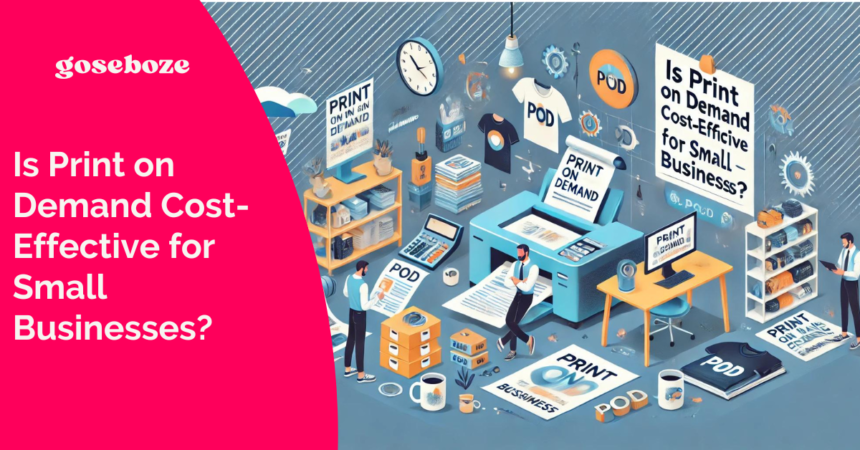Print on demand (POD) has become an increasingly popular choice for many small businesses looking to expand their product offerings without needing extensive production inventories. With its convenience and flexibility, POD has transformed how businesses operate in the modern age. But is print on demand cost-effective for small business owners? In this article, we will delve into the world of POD, discuss its advantages and drawbacks, and explore whether it truly lives up to its reputation as a cost-effective solution.
The Advantages of Print on Demand
1. No Need for Inventory
When it comes to traditional printing methods, one of the biggest challenges small business owners face is investing in inventory that may or may not sell. This ties up valuable financial resources and requires space for storage. With custom print on demand services for small businesses, there’s no need to worry about producing excess products because each item is printed only when an order is received. This means no upfront costs and reduced risk of dead stock.
2. Flexibility and Customization
Print on demand allows small business owners to offer various products without investing in different types or sizes. Whether t-shirts, mugs, phone cases, or even home decor items, POD providers have a vast range of products for customization. This flexibility enables entrepreneurs to cater to niche audiences or respond quickly to market trends with minimal hassle.
3. Reduced Time-to-Market
Creating new designs and getting them produced and shipped can be time-consuming in the traditional printing industry. With print on demand services, orders can be fulfilled almost immediately upon receiving them since there is no need for manufacturing or product preparation time. This quick turnaround time helps small businesses seize new opportunities swiftly while reducing time-to-market and staying competitive in fast-paced industries.
The Drawbacks of Print on Demand
1. Higher Per-item Cost
While overhead expenses associated with traditional printing methods are high, the per-unit cost of each product tends to decrease with increased quantity. However, print on demand providers typically charge a higher per-item cost due to the technology and convenience they offer. Small business owners may have to set higher product prices to maintain a healthy profit margin, potentially reducing customer demand.
2. Limited Control Over Product Quality and Branding
Outsourcing production to POD providers means giving up some control over the quality of materials and print finishes in exchange for convenience. As a result, there is always the risk of receiving inconsistent or lower-quality products that do not align with your brand’s standards. It’s essential to thoroughly research and vet potential POD partners before deciding on one to ensure they can meet your branding and quality requirements.
3. Competing in a Saturated Market
POD has gained immense popularity over the years, leading to increased competition in this space. With low barriers to entry, anyone can start a print on demand business, resulting in numerous sellers offering similar products. Standing out among the crowd requires extra effort in marketing strategy, unique designs, or niche targeting—factors that small businesses need to consider when weighing the cost-effectiveness of using print on demand as their primary production model.
Read Also: Brook B Taube: Entrepreneur, Investor, and Philanthropist
Determining Cost-Effectiveness for Small Business Owners
1. Consider Your Business Model and Projection
When evaluating whether print on demand is cost-effective for your small business, it is crucial to analyze your current business model alongside any future projections or goals you have set forth. Calculate upfront costs associated with traditional printing methods—such as inventory storage and manufacturing setup—and compare them against incremental expenses using a POD service.
2. Evaluate Long-term Financial Viability
Since POD might result in higher per-item costs than bulk ordering traditional prints, consider whether these added expenses align with your long-term financial goals and the feasibility of pricing structure within your target market segment.
Conclusion
While print on demand offers several advantages, including eliminating the need for inventory and minimizing time-to-market, small business owners need to evaluate its cost-effectiveness properly. By analyzing upfront expenses, revenue potential, brand control concerns, and consumer demand, entrepreneurs can identify whether print on demand is a viable solution aligning with their long-term objectives. With careful consideration of all these factors, print on demand is a cost-effective option for small business owners looking to expand their offerings without upfront investments and excessive inventory risks.

Morgan Reid, with an MBA and a decade in business strategy, specializes in boosting company performance and operational efficiency. Known for practical insights, Morgan contributes to publications and speaks at industry events, blending expertise with a passion for tech and business innovation.







